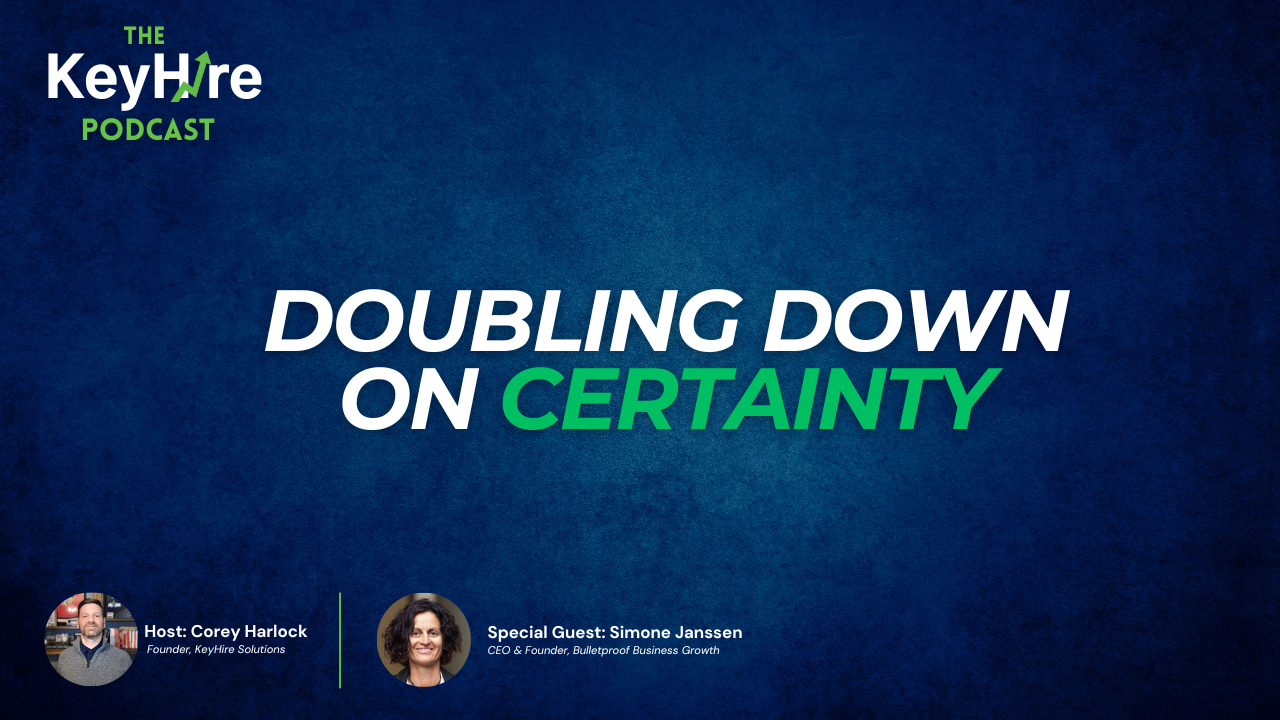Small Business Leadership Advice: Transforming Uncertainty Into Your Competitive Advantage

In today's volatile business environment, uncertainty has become the only constant. From supply chain disruptions to economic shifts, small business owners are facing unprecedented challenges that test their leadership abilities daily. But what if we told you that the key to thriving during uncertain times isn't about predicting the future—it's about creating certainty within your own organization?
In a recent episode of the KeyHire Solutions Podcast, host Corey Harlock sat down with Simone Janssen, founder of Bulletproof Business Growth, to explore how successful business owners are doubling down on certainty during these turbulent times. Their conversation revealed powerful insights that can help transform your leadership approach and drive sustainable growth.
The Foundation of Certainty: Understanding the 5 C's Framework
Simone introduced a compelling framework that forms the backbone of effective leadership during uncertain times—the 5 C's: Clarity, Context, Communication, Certainty, and Consistency. These elements work together to create a stable foundation that allows teams to perform at their best, regardless of external chaos.
Clarity means ensuring everyone understands the big picture and their role within it. Your team needs to know not just what they're doing, but why they're doing it and how it contributes to the overall vision.
Context involves providing the strategic framework that helps employees understand how their daily tasks connect to larger business objectives. When people understand the "why" behind their work, they become more engaged and productive.
Communication serves as the bridge between leadership vision and team execution. Regular, transparent communication prevents the confusion and misalignment that often derail small businesses during challenging periods.
Certainty is what you create when you successfully implement the other elements. As Simone explains, "The more uncertain the outside, the more organized and the more on the same page we need to be on the inside."
Consistency in implementing these principles ensures that your team knows what to expect and can rely on stable processes and clear expectations.
Business Growth Tips: Creating Your Strategic Planning Process
- Start with a one-page plan: Don't overcomplicate your strategic planning. A focused, one-page document that outlines your vision, values, methods, key metrics, opportunities, and challenges can provide tremendous clarity for your team.
- Focus on short-term wins: Whether it's a quarter or even a week, having a clear short-term plan helps teams understand immediate priorities and creates momentum through achievable goals.
- Cascade communication properly: Deliver your plan through your direct reports instead of to everyone at once. This preserves your leadership structure and guarantees consistent messaging across the organization.
- Make it collaborative: Include your team in the planning process. When people participate in creating the strategy, they're more invested in its success.
- Review and adjust regularly: Meet weekly with your leadership team to assess progress and make necessary adjustments. This keeps everyone aligned and responsive to changing conditions.
Scaling a Small Business: The People Challenge when dealing with Uncertainty
The transition from a startup to a more established business inevitably requires tough team decisions, especially during periods of uncertainty. As your company expands, some early team members may struggle to meet the new demands and responsibilities. This is one of the most challenging aspects of growing a business, but strong leadership plays a crucial role in this process.
The key is using what Simone calls a "litmus test" method. By setting clear expectations, offering proper support, and providing consistent feedback, you'll quickly see who can handle the new challenges and who cannot. Some team members will thrive under this clarity, while others may show that they are no longer suitable for their roles.
"When you, as a leader, provide that clarity—giving a clear vision, specific action plans, open communication, feedback, and support—you'll quickly identify who rises to the occasion," Simone explains. This method is fair to employees and vital for your business's ongoing success.
Small Business Challenges: The Common Pitfalls That Derail Growth During Uncertain Times
Small business owners frequently make predictable mistakes that limit their growth potential and create unnecessary stress. Understanding these pitfalls can help you avoid them and build a more resilient organization.
- Treating leadership development as a "nice to have": Many business owners push leadership development aside, thinking they'll get to it when they have more time or money. This is backward thinking; leadership development is what creates the time and resources for everything else.
- Failing to delegate effectively: The "I can do it faster myself" mentality becomes increasingly destructive as your business grows. While it might save time in the moment, it prevents your team from developing and creates a bottleneck that limits your company's potential.
- Avoiding difficult personnel decisions: Keeping underperforming employees in roles they've outgrown doesn't help anyone. It's not kind to the employee, and it's harmful to your business and other team members.
- Skipping the accountability structure: Without clear accountability, projects fall through the cracks, and team members become frustrated and disengaged. Everyone needs to know who's responsible for what and when it needs to be completed.
- Not hiring up soon enough: Many small business owners wait too long to bring in higher-level talent. This conservative approach often costs more in lost opportunities than the investment in better people would cost.
Avoiding Mistakes Related to Performance Management and Team Development
The KeyHire Podcast Episode reveals several critical mistakes that small business owners make when trying to manage performance and develop their teams during uncertain times:
Mistake #1: Setting unclear expectations without proper follow-through. Many leaders create performance improvement plans or set new KPIs, but then fail to provide regular feedback and check-ins. Your team members need to know whether they're meeting expectations, and they need this feedback consistently, not just during annual reviews.
Mistake #2: Assuming good intentions equal good results. Just because someone wants to help doesn't mean their help is valuable. Without clear role definitions and accountability structures, well-intentioned team members can actually create more work and confusion. Take time to define where each person can deliver the highest value.
Mistake #3: Avoiding difficult conversations about family and friend hires. Family businesses face unique challenges, but the same principles apply. As Simone wisely notes, "Don't hire who you can't fire." If someone isn't performing, addressing it quickly and directly is better for everyone involved, including relationships outside of work.
Mistake #4: Underestimating the importance of recognition and feedback. Even high-performing employees need to know they're valued. Regular recognition and constructive feedback aren't just nice gestures—they're essential for maintaining engagement and driving continued results.
Taking Action: Your Next Steps
Ready to implement these strategies in your business? Here's how to get started:
- Conduct a leadership audit: Honestly assess your current leadership practices using the 5 C's framework.
- Create your one-page strategic plan: Focus on the next quarter and identify your key priorities, success metrics, and potential obstacles.
- Schedule regular leadership meetings: Implement weekly check-ins with your direct reports to maintain alignment and address issues quickly.
- Review your team structure: Identify any roles where expectations aren't clear or accountability is missing. Address these gaps immediately.
- Invest in your leadership development: Whether through coaching, training, or consulting services like those offered by KeyHire Solutions, make leadership development a priority, not an afterthought.
Key Takeaways
- Certainty is created, not discovered: Your job as a leader is to create a stable environment where your team can thrive, regardless of external uncertainty.
- The 5 C's framework provides a roadmap: Clarity, Context, Communication, Certainty, and Consistency work together to build high-performing teams.
- People decisions are business decisions: Don't let personal relationships prevent you from making the personnel changes your business needs to grow.
- Leadership development is an investment, not an expense: The time and resources you invest in becoming a better leader will pay dividends in team performance and business results.
- Start small but start now: You don't need to implement everything at once. Choose one area to focus on and build momentum through consistent action.
The path forward isn't about eliminating uncertainty—it's about building an organization that can thrive regardless of what challenges come your way. By implementing these strategies and maintaining focus on your leadership development, you'll create the certainty your team needs to deliver exceptional results.
Want to dive deeper into this topic? Listen to the full conversation between Corey Harlock and Simone Jannsen on the KeyHire Small Business Podcast. For more insights on building stronger teams and scaling your business, visit KeyHire Solutions.
Learn more about Simone Jannsen: https://bulletproofbusinessgrowth.com/
Check out our sponsor:
Career Spring, Careers launch here: https://careerspring.org/
Connect With Us:
KeyHire Solutions, Be Our Next Success Story: https://www.keyhire.solutions/testimonials
Contact Corey: corey@keyhire.solutions











